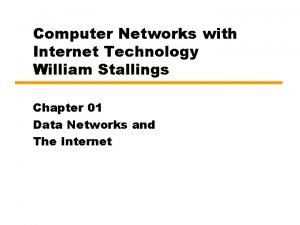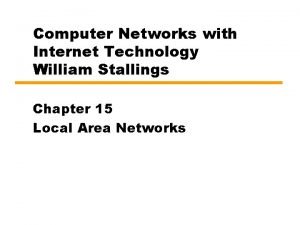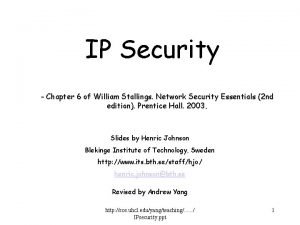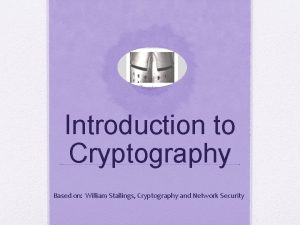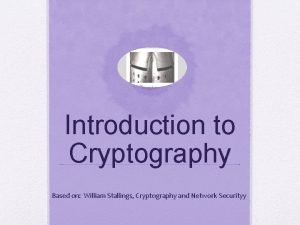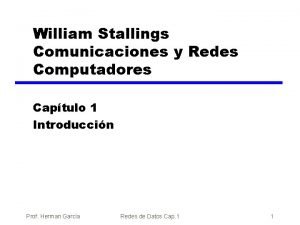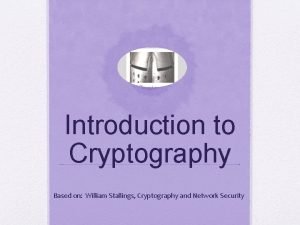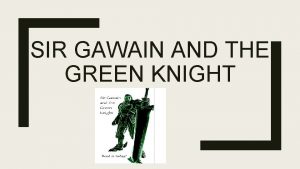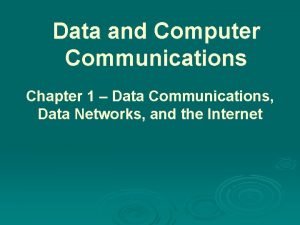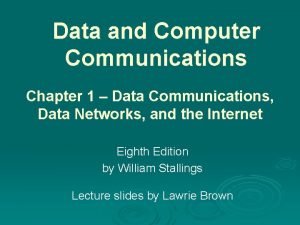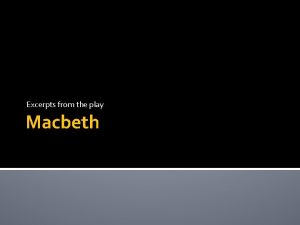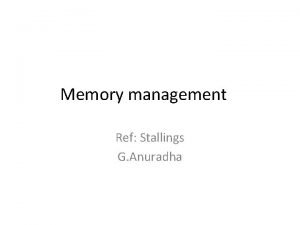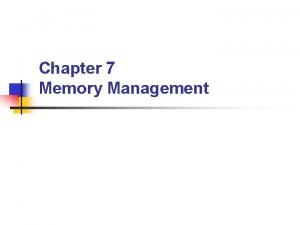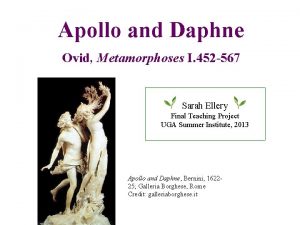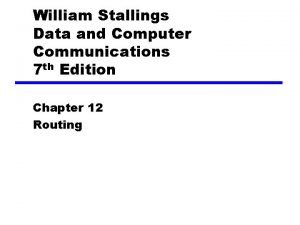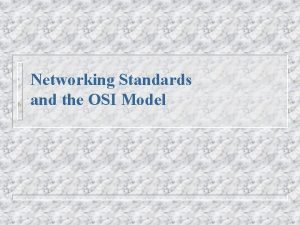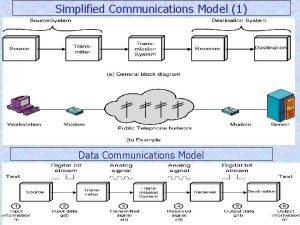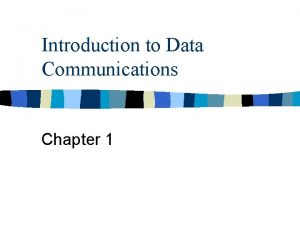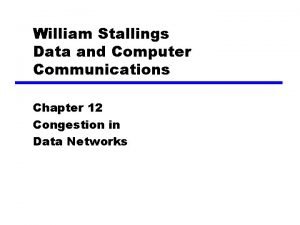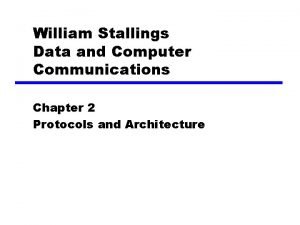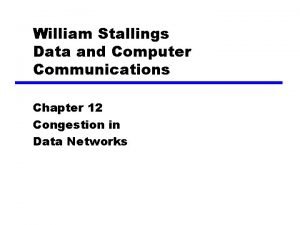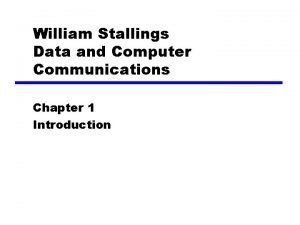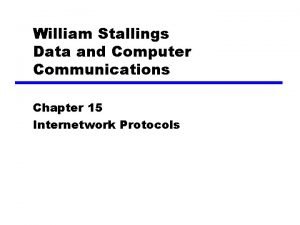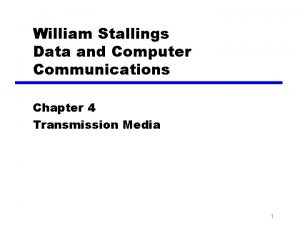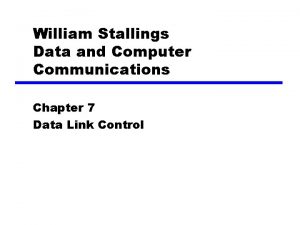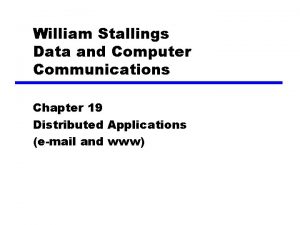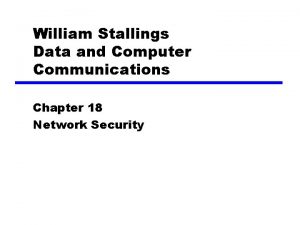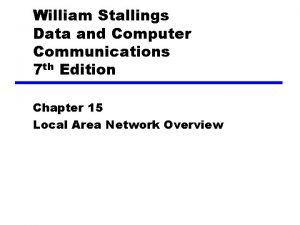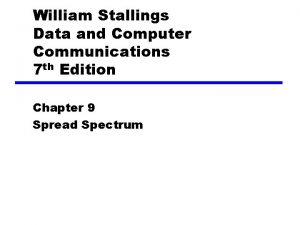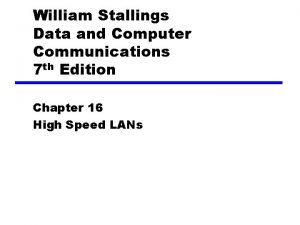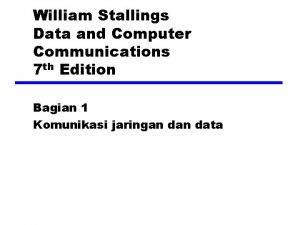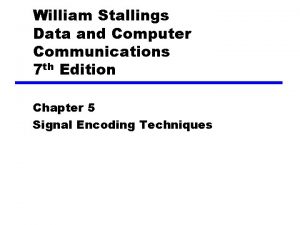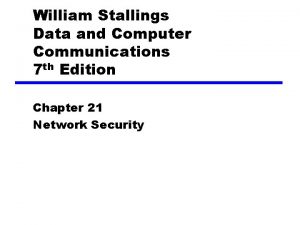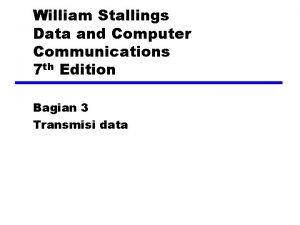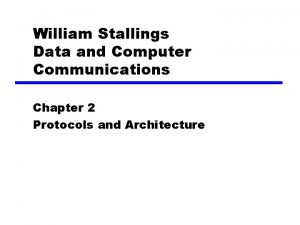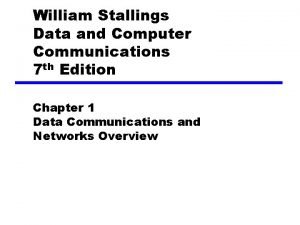William Stallings Data and Computer Communications Excerpts from





























- Slides: 29

William Stallings Data and Computer Communications Excerpts from Chapter 3, 4 and 6 Data Transmission Basics

Data Transmission q Converting into Electromagnetic (EM) signals q Transmitting those signals through medium q Medium Ø Guided medium o e. g. twisted pair, optical fiber Ø Unguided medium o e. g. air, water, vacuum

Spectrum & Bandwidth q Spectrum Ø range of frequencies contained in signal q bandwidth Ø width of spectrum

Data Rate and Bandwidth q A perfect square wave has inifinite bandwidth Ø Fourier analysis Ø cannot be transmitted over a medium due to medium restrictions Ø more bandwidth o less distortions o expensive Ø less bandwidth o more distortions ==> more errors o cheap q Higher bandwidth = higher data rate

Transmission Media q Guided Ø Twisted pair Ø Coaxial cable Ø Optical fibers q Unguided Ø radio Ø microwave Ø infrared

Electromagnetic Spectrum

Magnetic Media q Can give good data rate q Sometimes the best way : ) Ø especially for large volume of data transfer

Twisted Pair

Twisted Pair - Applications q Most common medium q Telephone network Ø Between house and local exchange (subscriber loop) q Within buildings Ø To private branch exchange (PBX) q For local area networks (LAN) Ø 10 Mbps or 100 Mbps

Twisted Pair - Pros and Cons q Cheap q Easy to work with q Low data rate q Short range

Twisted Pair - Transmission Characteristics q Analog Ø Amplifiers every 5 km to 6 km q Digital Ø Use either analog or digital signals Ø repeater every 2 km or 3 km

Unshielded and Shielded TP q Unshielded Twisted Pair (UTP) Ø Ordinary telephone wire Ø Cheapest Ø Easiest to install Ø Suffers from external EM interference q Shielded Twisted Pair (STP) Ø Metal braid or sheathing that reduces interference Ø More expensive Ø Harder to handle (thick, heavy) Ø IBM invention

UTP Categories q Cat 3 Ø up to 16 MHz Ø Voice grade found in most offices Ø Twist length of 7. 5 cm to 10 cm q Cat 5 Ø data grade Ø up to 100 MHz Ø Commonly pre-installed in new office buildings Ø Twist length 0. 6 cm to 0. 85 cm

Coaxial Cable

Coaxial Cable Applications q Most versatile medium q Television distribution Ø Ariel to TV Ø Cable TV q Long distance telephone transmission Ø Can carry 10, 000 voice calls simultaneously Ø Being replaced by fiber optic q Cable Internet q Local area networks

Coaxial Cable - Transmission Characteristics q Less susceptible to interference q Periodic amplifiers/repeaters are needed

Optical Fiber Core: thin fiber (8 - 100 micrometers), plastic or glass Cladding: Glass or plastic coating of fiber. Specially designed. Interface is a reflector. Jacket: plastic layer to protect against environmental dangers

Optical Fiber - Benefits q Greater capacity Ø Data rates of hundreds of Gbps q Smaller size & weight q Lower attenuation q Electromagnetic isolation Ø no interference Ø no crosstalk Ø more secure q Greater repeater spacing Ø 10 s of km at least

Optical Fiber - Applications q Long-haul trunks q Metropolitan trunks q Rural exchange trunks q Subscriber loops q LANs

Wireless Transmission q Unguided media q Transmission and reception via antenna q Directional Ø Focused beam Ø Careful alignment required q Omnidirectional Ø Signal spreads in all directions Ø Can be received by many antennae

Frequencies q 1 GHz to 40 GHz Ø referred as microwave frequencies Ø Highly directional Ø Point to point Ø Satellite q 30 MHz to 1 GHz Ø Omnidirectional Ø Broadcast radio

Terrestrial Microwave q Typical antenna is a parabolic dish q Focused beam q Line of sight transmission q Long haul telecommunications Ø voice and video (TV) Ø what are the advantages/disadvantages of using microwave by a long-distance telephone company? o no right-of-way needed o needs periodic towers o sensitive to atmospheric conditions – e. g. multipath fading Ø alternative: fiber optic – needs right-of-way

Satellite Microwave q Satellite is relay station q Satellite receives on one frequency, amplifies or repeats signal and transmits on another frequency Ø transponder = frequency channel q may also broadcast Ø TV q Requires geo-stationary orbit q Television q Long distance telephone q Private business networks

Asynchronous and Synchronous Transmission q Problem: SYNCHRONIZATION Ø Sender and receiver must cooperate Ø must know when to start and stop sampling Ø must know the rate of data q Two solutions Ø Asynchronous Ø Synchronous

Asynchronous Transmission q No long bit streams q Data transmitted one character at a time Ø generally 7 - 8 bits per character q Prior communication, both parties must Ø agree on the data rate Ø agree on the character length in bits

Asynchronous Transmission

Asynchronous Transmission Behavior q In idle state, receiver looks for 1 to 0 transition q Then samples next “character length” intervals q Then looks for next 1 to 0 for next char q Stop bit is used to make sure a 1 to 0 transition for the next character q Overhead is 2 or 3 bits per char (start, stop and/or parity bits)

Synchronous Transmission q Block of data transmitted without start or stop bits q No overhead (except error detection/correction codes) q Common clock Ø generally sender-generated Ø data is sampled once per clock cycle Ø clock starts ==> data starts Ø clock stops ==> data stops Ø no further synchronization needed for short distance and point to point communication

Synchronous Transmission q Synchronous communication concept in Computer Networking is different q Need to indicate start and end of block q Use preamble and postamble flags q More efficient (lower overhead) than async
 Simplified data communication model
Simplified data communication model Computer organization and architecture william stallings
Computer organization and architecture william stallings William stallings computer networks
William stallings computer networks William stallings computer networks
William stallings computer networks Network security essentials 5th edition
Network security essentials 5th edition Kr
Kr William stallings
William stallings Congruence relation
Congruence relation Stallings william comunicaciones y redes de computadores
Stallings william comunicaciones y redes de computadores Cryptography william stallings
Cryptography william stallings Read the excerpt from sir gawain and the green knight
Read the excerpt from sir gawain and the green knight Data and computer communications 10th edition
Data and computer communications 10th edition Data and computer communications
Data and computer communications Data and computer communications
Data and computer communications Excerpts from macbeth
Excerpts from macbeth French revolutio
French revolutio Stallings garbage pickup
Stallings garbage pickup Garbage pickup stallings
Garbage pickup stallings Hanc quoque phoebus amat
Hanc quoque phoebus amat Metodo stallings
Metodo stallings Least cost routing algorithm
Least cost routing algorithm Telecommunication meaning
Telecommunication meaning Backbone network components
Backbone network components Business data communication and networking
Business data communication and networking Introduction to data communications and networking
Introduction to data communications and networking Business data communications and networking
Business data communications and networking Network communication models
Network communication models Explain data communication model
Explain data communication model Introduction to data communications
Introduction to data communications General objectives of computer
General objectives of computer


